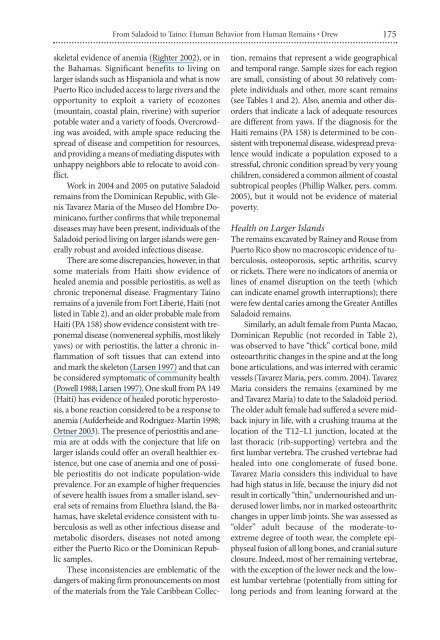Create successful ePaper yourself
Turn your PDF publications into a flip-book with our unique Google optimized e-Paper software.
<strong>From</strong> <strong>Saladoid</strong> <strong>to</strong> <strong>Taíno</strong>: <strong>Human</strong> <strong>Behavior</strong> <strong>from</strong> <strong>Human</strong> <strong>Rema<strong>in</strong>s</strong> • Drew 175<br />
skeletal evidence of anemia (Righter 2002), or <strong>in</strong><br />
<strong>the</strong> Bahamas. Significant benefits <strong>to</strong> liv<strong>in</strong>g on<br />
larger islands such as Hispaniola and what is now<br />
Puer<strong>to</strong> Rico <strong>in</strong>cluded access <strong>to</strong> large rivers and <strong>the</strong><br />
opportunity <strong>to</strong> exploit a variety of ecozones<br />
(mounta<strong>in</strong>, coastal pla<strong>in</strong>, river<strong>in</strong>e) with superior<br />
potable water and a variety of foods. Overcrowd<strong>in</strong>g<br />
was avoided, with ample space reduc<strong>in</strong>g <strong>the</strong><br />
spread of disease and competition for resources,<br />
and provid<strong>in</strong>g a means of mediat<strong>in</strong>g disputes with<br />
unhappy neighbors able <strong>to</strong> relocate <strong>to</strong> avoid conflict.<br />
Work <strong>in</strong> 2004 and 2005 on putative <strong>Saladoid</strong><br />
rema<strong>in</strong>s <strong>from</strong> <strong>the</strong> Dom<strong>in</strong>ican Republic, with Glenis<br />
Tavarez Maria of <strong>the</strong> Museo del Hombre Dom<strong>in</strong>icano,<br />
fur<strong>the</strong>r confirms that while treponemal<br />
diseases may have been present, <strong>in</strong>dividuals of <strong>the</strong><br />
<strong>Saladoid</strong> period liv<strong>in</strong>g on larger islands were generally<br />
robust and avoided <strong>in</strong>fectious disease.<br />
There are some discrepancies, however, <strong>in</strong> that<br />
some materials <strong>from</strong> Haiti show evidence of<br />
healed anemia and possible periostitis, as well as<br />
chronic treponemal disease. Fragmentary <strong>Taíno</strong><br />
rema<strong>in</strong>s of a juvenile <strong>from</strong> Fort Liberté, Haiti (not<br />
listed <strong>in</strong> Table 2), and an older probable male <strong>from</strong><br />
Haiti (PA 158) show evidence consistent with treponemal<br />
disease (nonvenereal syphilis, most likely<br />
yaws) or with periostitis, <strong>the</strong> latter a chronic <strong>in</strong>flammation<br />
of soft tissues that can extend <strong>in</strong><strong>to</strong><br />
and mark <strong>the</strong> skele<strong>to</strong>n (Larsen 1997) and that can<br />
be considered symp<strong>to</strong>matic of community health<br />
(Powell 1988; Larsen 1997). One skull <strong>from</strong> PA 149<br />
(Haiti) has evidence of healed porotic hyperos<strong>to</strong>sis,<br />
a bone reaction considered <strong>to</strong> be a response <strong>to</strong><br />
anemia (Aufderheide and Rodriguez-Mart<strong>in</strong> 1998;<br />
Ortner 2003). The presence of periostitis and anemia<br />
are at odds with <strong>the</strong> conjecture that life on<br />
larger islands could offer an overall healthier existence,<br />
but one case of anemia and one of possible<br />
periostitis do not <strong>in</strong>dicate population-wide<br />
prevalence. For an example of higher frequencies<br />
of severe health issues <strong>from</strong> a smaller island, several<br />
sets of rema<strong>in</strong>s <strong>from</strong> Eluethra Island, <strong>the</strong> Bahamas,<br />
have skeletal evidence consistent with tuberculosis<br />
as well as o<strong>the</strong>r <strong>in</strong>fectious disease and<br />
metabolic disorders, diseases not noted among<br />
ei<strong>the</strong>r <strong>the</strong> Puer<strong>to</strong> Rico or <strong>the</strong> Dom<strong>in</strong>ican Republic<br />
samples.<br />
These <strong>in</strong>consistencies are emblematic of <strong>the</strong><br />
dangers of mak<strong>in</strong>g firm pronouncements on most<br />
of <strong>the</strong> materials <strong>from</strong> <strong>the</strong> Yale Caribbean Collection,<br />
rema<strong>in</strong>s that represent a wide geographical<br />
and temporal range. Sample sizes for each region<br />
are small, consist<strong>in</strong>g of about 30 relatively complete<br />
<strong>in</strong>dividuals and o<strong>the</strong>r, more scant rema<strong>in</strong>s<br />
(see Tables 1 and 2). Also, anemia and o<strong>the</strong>r disorders<br />
that <strong>in</strong>dicate a lack of adequate resources<br />
are different <strong>from</strong> yaws. If <strong>the</strong> diagnosis for <strong>the</strong><br />
Haiti rema<strong>in</strong>s (PA 158) is determ<strong>in</strong>ed <strong>to</strong> be consistent<br />
with treponemal disease, widespread prevalence<br />
would <strong>in</strong>dicate a population exposed <strong>to</strong> a<br />
stressful, chronic condition spread by very young<br />
children, considered a common ailment of coastal<br />
subtropical peoples (Phillip Walker, pers. comm.<br />
2005), but it would not be evidence of material<br />
poverty.<br />
Health on Larger Islands<br />
The rema<strong>in</strong>s excavated by Ra<strong>in</strong>ey and Rouse <strong>from</strong><br />
Puer<strong>to</strong> Rico show no macroscopic evidence of tuberculosis,<br />
osteoporosis, septic arthritis, scurvy<br />
or rickets. There were no <strong>in</strong>dica<strong>to</strong>rs of anemia or<br />
l<strong>in</strong>es of enamel disruption on <strong>the</strong> teeth (which<br />
can <strong>in</strong>dicate enamel growth <strong>in</strong>terruptions); <strong>the</strong>re<br />
were few dental caries among <strong>the</strong> <strong>Greater</strong> <strong>Antilles</strong><br />
<strong>Saladoid</strong> rema<strong>in</strong>s.<br />
Similarly, an adult female <strong>from</strong> Punta Macao,<br />
Dom<strong>in</strong>ican Republic (not recorded <strong>in</strong> Table 2),<br />
was observed <strong>to</strong> have “thick” cortical bone, mild<br />
osteoarthritic changes <strong>in</strong> <strong>the</strong> sp<strong>in</strong>e and at <strong>the</strong> long<br />
bone articulations, and was <strong>in</strong>terred with ceramic<br />
vessels (Tavarez Maria, pers. comm. 2004). Tavarez<br />
Maria considers <strong>the</strong> rema<strong>in</strong>s (exam<strong>in</strong>ed by me<br />
and Tavarez Maria) <strong>to</strong> date <strong>to</strong> <strong>the</strong> <strong>Saladoid</strong> period.<br />
The older adult female had suffered a severe midback<br />
<strong>in</strong>jury <strong>in</strong> life, with a crush<strong>in</strong>g trauma at <strong>the</strong><br />
location of <strong>the</strong> T12–L1 junction, located at <strong>the</strong><br />
last thoracic (rib-support<strong>in</strong>g) vertebra and <strong>the</strong><br />
first lumbar vertebra. The crushed vertebrae had<br />
healed <strong>in</strong><strong>to</strong> one conglomerate of fused bone.<br />
Tavarez Maria considers this <strong>in</strong>dividual <strong>to</strong> have<br />
had high status <strong>in</strong> life, because <strong>the</strong> <strong>in</strong>jury did not<br />
result <strong>in</strong> cortically “th<strong>in</strong>,” undernourished and underused<br />
lower limbs, nor <strong>in</strong> marked osteoarthritc<br />
changes <strong>in</strong> upper limb jo<strong>in</strong>ts. She was assessed as<br />
“older” adult because of <strong>the</strong> moderate-<strong>to</strong>extreme<br />
degree of <strong>to</strong>oth wear, <strong>the</strong> complete epiphyseal<br />
fusion of all long bones, and cranial suture<br />
closure. Indeed, most of her rema<strong>in</strong><strong>in</strong>g vertebrae,<br />
with <strong>the</strong> exception of <strong>the</strong> lower neck and <strong>the</strong> lowest<br />
lumbar vertebrae (potentially <strong>from</strong> sitt<strong>in</strong>g for<br />
long periods and <strong>from</strong> lean<strong>in</strong>g forward at <strong>the</strong>


















